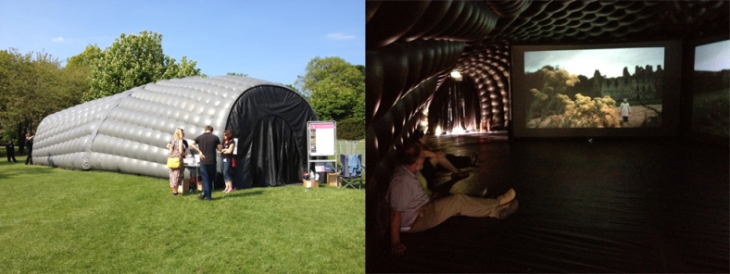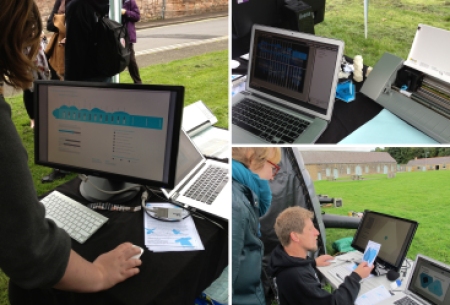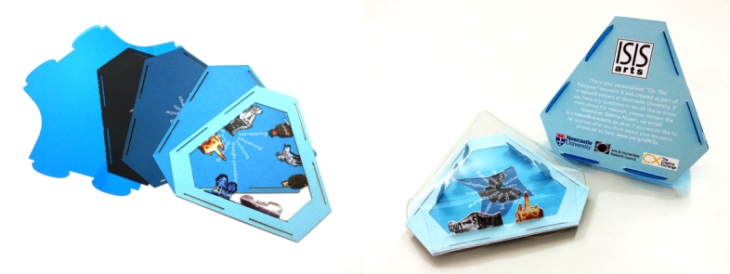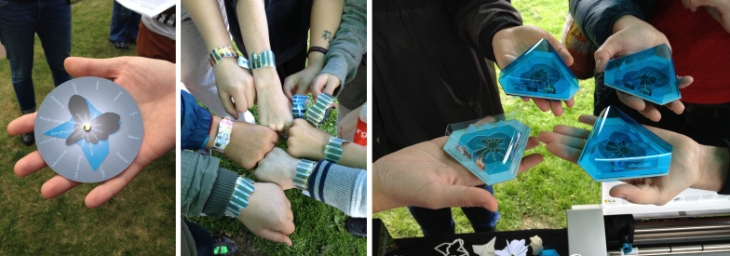Using digital fabrication to engage audiences in reflection and evaluation of an immersive video installation

To understand the context of the experience of this transient video art installation in the Big M, we visited the show ourselves and gathered initial feedback from visitors through traditional questionnaires that are still regularly used by arts organisations to evaluate their events or exhibitions. We developed a set of different questionnaires, some more impressionistic and others more parametric, in order to gather a wide variety of feedback and better understand the experience itself and how visitors would describe or articulate their thoughts.


We used the information we gathered in these first sessions to design and develop a set of souvenir making activities incorporating digital fabrication technology to create personalised souvenirs based on each visitor’s experience. Visitors who were exiting the Big M had the opportunity to create their own, individual souvenir while giving feedback on the show. A digital interface allowed visitors to answer a few questions relating to their experience of the show. The replies visitors entered then generated personalised shapes unique to each visitor as well as an accumulated average of all visitor’s feedback. After the participant finished creating their unique digital shape the souvenir was digitally fabricated for them while they were waiting, watching and asking questions. We used a cutter plotter for speed and immediacy of fabrication so visitors didn’t need to wait very long to receive their unique object.

In comparison with the earlier questionnaires, we found that this activity was particularly engaging for younger audiences who were disinterested in filling in surveys but were captivated by the novelty of the fabrication process and the chance of taking a special object with them. This gave the visitors who were keen to participate an opportunity to reflect on their experience and discuss this either amongst themselves, if in a group, or with us to develop a better understanding of the work and their experience. Because of the reflective process of this activity, we were able to extend and deepen the audience’s visit and engagement with the topic of the show. This not only gave the visitor the possibility to reflect on their experience but it also enabled the arts organisation to capture visitor information in a more playful and engaging way which they can use for further evaluations and funding proposals. With arts organisations operating in a very creative context why shouldn’t the often unexciting but important process of evaluation be turned into a more creative experience that will allow both the audience and organisation to find out more about each other and their experiences?

This project was conducted in collaboration with Jon Hook, John Bowers, Peter Wright, Christopher Newell and ISIS Arts.
Associated publications:
Bowen, S., Durrant, A., Nissen, B., Bowers, J. and Wright, P. The Value of Designers Creative Practice within Complex Collaborations. Design Studies (2016) [link]
Nissen, B. Digitally Fabricating Data-Things: A Participatory Approach to Making Data Physical. Workshop contribution to ‘Exploring the Challenges of Making Data Physical‘ at CHI’2015 [pdf]
Nissen, B., Bowers, J., Wright, P., Hook, J., Newell, C. Volvelles, Domes and Wristbands: Embedding Digital Fabrication within a Visitor’s Trajectory of Engagement. In Proc. DIS 2014, ACM (2014) [pdf] [link]